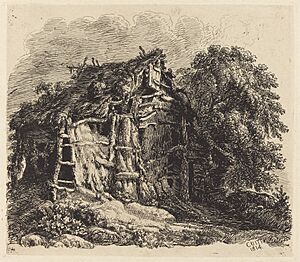George Cuitt the Younger facts for kids
George Cuitt the Younger (1779 – 1854) was a talented English artist. He was known for his paintings and especially for his etchings. Etching is a way of making prints by drawing on a metal plate with acid.
Early Life and Artistic Beginnings
George Cuitt was born in 1779 in Richmond, Yorkshire. He was the only son of another painter, George Cuitt the Elder. George Cuitt the Younger learned to paint from his father when he was young.
Becoming an Etcher
He also became very skilled at etching. He learned this art by carefully studying the works of a famous Italian artist named Piranesi. Piranesi was known for his detailed etchings of ancient Roman buildings.
George Cuitt moved to Chester, where he taught drawing. While in Chester, he published several collections of his etchings. These included:
- Six Etchings of Saxon and other Buildings remaining at Chester (1810-1811)
- Six Etchings of Old Buildings in Chester (1810-1811)
- Six Etchings of Picturesque Buildings in Chester (1810-1811)
- Five etchings for a History of Chester (1815)
These etchings showed old and interesting buildings in Chester.
Later Life and Famous Works
Around 1820, George Cuitt had earned enough money from his art. He decided to stop working full-time. He built a house in Masham, a town near Richmond.
From his home in Masham, he published more of his important works. One collection was called Yorkshire Abbeys. In 1848, he gathered all his etchings into a book. This collection was titled Wanderings and Pencillings amongst the Ruins of Olden Times.
His etchings showed great skill and creativity. They were lively, original, and looked very real.
George Cuitt the Younger passed away in Masham in 1854.


